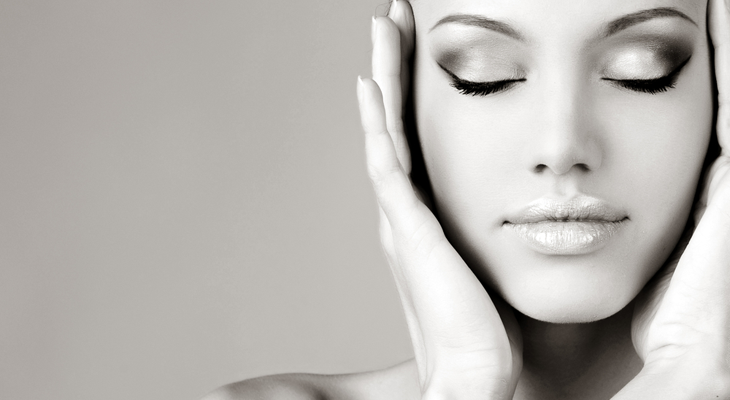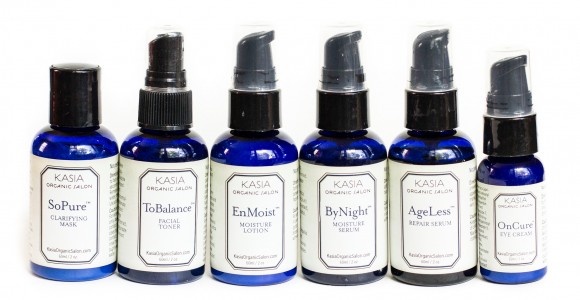Skin Care and Hormonal Balance 101
Understanding hormones and their effect on the skin, from the teenage years to perimenopause and menopause, is challenging for many skin care specialists. Journeying through the roller coaster with many clients can be rough sailing.
Understanding the prominent hormones in the body is essential in order to correctly diagnose, treat and prevent hormone related skin conditions. Estrogen and progesterone are the main partners in this delicate balancing act. Designed to work together as a team, when that balance leans more to one direction than the other, a whole host of problems occur.
Estrogen – is one of the most important hormones for women. Not only does it regulate a women’s reproductive cycle but is also can have very positive effects on the skin, but only if the levels are in balance. Estrogen can reduce the size and activity of the oil glands inside the pore; help tighten pores, influence how quickly cells divide in order to create strong collagen and elastin, help increase the hydration levels within the skin, and slow hair growth. Without estrogen, the skin ages quickly, this is why women see rapid changes in their skin as they enter menopause.
Hormone levels in the blood stream play a significant role in the skin rejuvenation practice as they affect the shedding of cells in the epidermis and the building of cells in the dermis.
Progesterone – named because it is involved in gestation or maturing of a fetus in the womb, stimulates a woman’s uterus and prepares the lining for a fertilized ovum. Progesterone also stops ovulation from occurring when pregnancy occurs.
Testosterone – usually thought of as only a male hormone but is produced in women as well at a much lower level.
DHEA – or dehydroepiandrosterone, is a sterone naturally produced by the body’s adrenal glands and is responsible for the production of every sex hormone, such as progesterone or testosterone, in the body. DHEA levels begin to rise during puberty and are at their highest at the end of the teenage years and early twenties, but the levels start to decrease quickly as the aging process continues, and by post menopause DHEA production is merely a fraction of what it was in a person’s late teens and early twenties.
Human Growth Hormone – is an endocrine hormone like estrogen or testosterone, produced in the pituitary gland and secreted throughout a person’s lifetime but rapidly decreasing as a person ages.
The teenage years, when puberty occurs, is when the body begins producing sex hormones which can radically affect the skin throughout life as the levels continue to fluctuate. Early to mid- adult life is characterized by outside hormonal influences, pregnancy and lifestyle factors that affect hormones.Then comes menopause,the time when hormones can wreck havoc on the skin during fluctuations.These hormonal changes that come about during aging are undeniable and inescapable, but they can be eased by a healthy lifestyle and newly emerging anti-aging treatments
Where it all begins: The Teenage Years
Hormones are responsible for the maturation of the oil glands in our skin.This is why children do not experience acne.There are several times in our lives when hormones can become unbalanced and wreak havoc, including puberty, pregnancy and menopause. Hormones fluctuate, and the skin is influenced tremendously by these shifts. The menstrual cycle, which begins at puberty, plays a role in shifting hormone levels.The increase in progesterone prior to a women’s period can easily cause breakouts as male androgen hormone increase sebum activity in the sebaceous gland.The acne flare subsides after the onset of menstruation and the woman’s body moves into the beginning of another menstrual cycle.

Estrogen-dominant women have few acne breakouts during puberty.They continue, throughout most of their child rearing years, with relatively clear skin, unless something occurs that alters the hormonal balance. However, androgen (a male sex hormone) dominant women can suffer from full-blown acne during puberty, may suffer with excess facial and body hair, and be more prone to oily skin which may be the cause of breakouts and skin issues.
Many teenagers struggle with acne due to their changing hormones.To achieve the best possible results for young skin the face needs to be kept clean, hands need to be washed frequently and kept away from the face. Oil-free cosmetics like foundation, blush and moisturizing products that do not cause blocked pores should be used.
Mild glycolic (alpha hydroxy acid derived from sugarcane increases desquamation to refine, lighten and brighten the skins surface) and salicylic acid (a natural anti-bacterial derived from wintergreen exfoliates superficial skin cell layers to accelerate the removal of hyperpigmented brown and red skin discoloration) products should be used. Clarifying cleansers and toners containing these acids should be used in the morning, at bedtime and after heavy exercise. Most sun damage that presents itself during the later stages in life is actually due to sun exposure during the teenage years so an SPF15 or higher sunscreen should be applied daily to help avoid acne breakouts and hyperpigmentation. Even oily-skin types need to use a moisturizer with SPF in the morning and a light anti-bacterial moisturizer in the evening after cleansing to protect from surface dehydration.
The best approximate age to start a professional skin health regime is 13 or 14 years old. By this age, young adults know the importance of hygiene. By devoting a few extra minutes each day to a complete skin care routine, teens can gently ease through these erratic hormonal years with confidence.
Stuck in the Middle: The Mid-Life Skin Care
During early to mid-adulthood, a women’s body is producing skin-enhancing estrogen. If a woman’s estrogen levels are balanced, her oil production will be less and her skin elasticity will be enhanced. But around the age of 40, a woman’s estrogen levels begin to decline.
Like estrogen, anti–aging hormones, such as DHEA or human growth hormone (HGH), are at a peak during your early adulthood but begin to fall as aging progresses.
The natural aging process can cause a woman’s hormone levels to decrease but a woman’s lifestyle can also play a big role in hormonal imbalance. In this middle portion of a woman’s life she may be stressed, be receiving external forms of estrogen, be taking birth control or even be struggling with the middle age bulge, which can all affect your hormonal levels, and in turn affect the skin.
The androgen hormone testosterone is produced in a women’s adrenal gland and androgen- dominant females may have enlarged oil glands that produce excessive sebum, or oil. While androgen- dominant females may suffer from acne due to excessive oil during puberty or the teen years, factors during this stage of a women’s life, such as birth control pills and stress, can stimulate the androgens and can even cause hair growth on the face. However, these women can begin to notice a reduction in oil production as they progress in age.
As we age, there is a deceleration of cell renewal in the dermis contributed to by hormone levels in the blood stream.
The Last Stage: Menopause
Skin Care and the Hormonal Balance
Menopause brings on many symptoms in a women’s body internally, but the main place we visibly see the results of the changes is the skin.The body’s essential hormones are lacking,or missing altogether, during this stage in life and it is important to take extra care of the skin, the body’s largest organ, at this time.
During menopause, a stage in a woman’s life when the ovaries begin to produce less estrogen, skin may begin to suffer from dryness, loss of elasticity and previous abuses of the skin (smoking, lifestyle, sun damage) begin to expose themselves.
Not only will the body start producing less estrogen, it will slow down on the production of collagen and elastin as well.The women,who were estrogen-dominant in their teenage and early adulthood years,usually become more androgen-influenced.These women who escaped their early years without acne breakouts may start breaking out during this phase in life. Rosacea can also come about for these women at this stage. Without estrogen, the skin ages quickly, this is why women see rapid changes in their skin as they enter menopause.
Estrogen Replacement Therapy (ERT) is sometimes prescribed by a doctor to battle some symptoms of menopause such as hot flashes; however, there are side effects which present themselves in the skin including rosacea, cherry angiomas or appearance of blood vessels. But, ERT can also help by adding moisture to the skin, reducing skin wrinkling and protecting against skin conditions characterized by this age group and menopause. Women who receive hormonal therapy could see greater skin thickness than women who go untreated, and atrophy of the skin cells may be prevented by using an ERT. Estrogen Replacement Therapy is not recommended to everyone and does have some negative side effects so it is important to consult your doctor before using this Hormone Replacement Therapy (HRT).
Post-menopausal skin care can guard against the typical skin symptoms of this stage. A women’s daily regime should include the use of a non-oily, low foaming cleanser to protect the skin from drying. After cleansing, a non-alcoholic toner should be applied to balance the pH level of the skin followed by sun protection, retinol and or peptide serum and moisturizer. An exfoliator and mask for weekly skin conditioning maintenance is also recommended.
Cosmeceutical Ingredients Effective in the Treatment of Aging Skin
GLYCOLIC ACID POLYMER – Alpha hydroxy acid (AHA) derived from sugarcane that increases desquamation to refine the skins surface.
L-ASCORBIC ACID – The most effective aqueous topical vitamin C to prevent premature aging.
LACTIC ACID – An alternative to glycolic acid derived from sour milk increases cellular desquamation for sensitive and aging skin.
L-RETINOL – A pro-drug that can be converted to retinoic acid by the skin to promote the normalization of epithelial desquamation reducing cellular cohesion.
MATRIXYL 3000 TM PALMITOYL OLIGOPEPTIDE, PALMITOYL TETRAPEPTIDE-7 – Derived from fatty acids synthesis collagen and fibronectan reducing wrinkle density and volume.
BLACK CURRANT SEED OIL – Essential fatty acid anti-oxidants with skin hydrating benefits.
APRICOT KERNEL OIL – Increases cellular hydration and moisture retention for prematurely aged skin and skin that is dry and irritated. High in vitamin A and minerals, apricot kernel oil has an excellent texture that is great for all skin types to soften rough dry skin.
RICE BRAN OIL – Contains high levels of tocotrienol antioxidants to defend against free radicals generated in the skin by UV rays. It prevents skin aging and damage by oxidative UV rays.
CORN SILK – A rich source of vitamin K to diminish dark circles under the eyes and reduce the appearance of fine lines and wrinkles.
ENZYMES – Categorized as proteases; proteolytic enzymes, break down keratinized protein molecules. As bio-catalysts, which literally mean either beginning a cellular action or causing a reaction, enzymes are capable of effecting changes in the appearance of the skin such as releasing dead skin cells to decongest clogged pores and soften wrinkles.They also act as protectants,capturing free radicals preventing damage to the skin caused by environmental pollution, smoking, bacteria, sunlight and other harmful factors.
SQUALENE – Derived from olive oil and used as an antioxidant to prevent dehydration softening the appearance of fine lines and wrinkles.
TRICHLOROACETIC ACID (TCA) – Found in fermented apple cider, wine, grain, malt, rice or potato mashes is known as an ethanoic acid, an organic chemical compound. Considered to be the “Gold Standard”of peeling agents,TCA coagulates stratum corneum proteins causing a mild sloughing of photo-damaged epidermal cell layers to improve fine surface wrinkles superficial blemishes and pigment problems.
Start a healthy skin care routine and plan with our Kasia Holistic Skin Expert today! You can receive affordable facials MONTHLY, by signing up to our VIP Membership Program.
